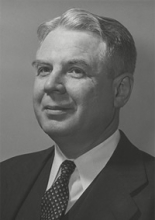Carl McFarland

Early History/Schooling: Born in Seattle, Washington in 1904, Carl McFarland attended the University of Montana where he received his B.A., M.A., and LL.B. degrees. He later received an S.J.D. from Harvard Law School in 1932.
Tenure as AAG: McFarland was appointed to the position of Assistant Attorney General for the Lands Division in 1937 by President Franklin Roosevelt. In addition to supervising the work of the Division, he continued to play a significant role in formulating the defense of the Roosevelt Administration’s New Deal legislation.
Career: After receiving his degree from Harvard Law School, McFarland returned to Montana where he joined the law firm of Toohey and McFarland. His tenure there was short-lived, however, as he accepted the position of Commissioner of the codification of the Montana statutes for the Montana Supreme Court in early 1933. He remained at this job for a brief period of time, leaving to join the Department of Justice in 1933 as a special assistant in the antitrust division.
However, in the fall of 1933, McFarland was selected by Attorney General Homer S. Cummings to serve as vice-chair of a secret project initiated at the direction of the President to investigate ways to curb the power of the judiciary. Anticipating that the Supreme Court could declare much of Roosevelt’s New Deal legislation – including the National Recovery Act, the Agricultural Adjustment Act, and the Social Security Act – to be unconstitutional, McFarland and others researched ways to limit or eliminate the Court’s authority to declare statutes unconstitutional. McFarland reputedly played the key role in formulating Roosevelt’s 1937 court-packing plan, a legislative initiative to allow the President to appoint an additional member of the Court for every sitting justice over the age of 70 ½. During this time, McFarland co-wrote Federal Justice, a history and examination of the Attorney General position, with then-Attorney General Cummings.
McFarland continued as a special assistant until he was appointed AAG in 1937. In 1939, he joined Attorney General Cummings’ D.C. practice, Cummings and Stanley. In the 1940s, McFarland was an active member of the American Bar Association’s Legislation and Administrative Law Committee where he helped to write the Administrative Procedure Act which became law in 1946. For that legislation, he was awarded the American Bar Association’s Gold Medallion. In 1951, McFarland became president of his alma mater, the University of Montana where he remained until becoming a professor at the University of Virginia Law School in 1959. He later was a member of both the Hoover Commission and the President’s Conference on Administrative Procedure. He retired from teaching in 1975.
Personal: McFarland married Patricia Regan. He died in 1979.
This material is based on the review of a variety of historical sources, and its accuracy cannot be guaranteed. If you have any corrections or additional information about this individual or about the history of the Division, please contact ENRD.

 U.S. Department
of Justice
U.S. Department
of Justice